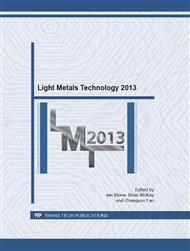p.3
p.8
p.13
p.18
p.23
p.28
p.33
p.38
Castable Aluminium Alloys for High Temperature Applications
Abstract:
Most traditional aluminium casting alloys are based on the aluminium-silicon eutectic system because of its excellent casting characteristics. However, the solidus in this system does not exceed 577 °C and the major alloying elements used with silicon in these alloys have high diffusivity in aluminium. Therefore, while these elements enhance the room temperature strength of the alloy, they are not useful at elevated temperatures. Considering nickel-base superalloys, whose mechanical properties are retained up to temperatures that approach 75% of their melting point, it is conceivable that castable aluminium alloys can be developed on the same basis so that they are useful at temperatures approaching 300 °C. In this publication, we present the thought process behind developing a new castable aluminum alloy that is designed specifically for such high temperature applications and we present the alloy’s measured castability characteristics and its elevated temperature tensile properties.
Info:
Periodical:
Pages:
8-12
Citation:
Online since:
July 2013
Authors:
Keywords:
Price:
Сopyright:
© 2013 Trans Tech Publications Ltd. All Rights Reserved
Share:
Citation:


